Jade plants are easier to care for than most people think, even for beginners. They grow very well either indoors or outside, and can live for many, many years.
In this complete jade plant care guide, I will show you all you need to know for the best success. We’ll cover everything, from water, light, and soil, to pest control, fertilizer, troubleshooting common problems, and much more.
I have been growing jade plants, both indoors and outside, for a few decades. In fact, I still have the very first one I ever bought waaaay back in 2001, and it’s one of the oldest plants I own.
When I got it, it was a tiny thing in a 4″ pot, and now it’s about 3′ tall and wide (it’s the one in the photo above). Since then, I’ve added several others to my collection (you’ll see some of them in the pictures below). Every one of them is thriving, and I love them all.
Needless to say, I was very excited to write this guide to share my wealth of knowledge and expert hands-on experience with all of you.
Quick Jade Plant Care Overview
| Scientific name: | Crassula |
| Classification: | Succulent plant |
| Common names: | Jade plant, Money plant |
| Hardiness: | Zones 9-11 |
| Temperature: | 55-85°F |
| Flowers: | White or pink, blooms in winter |
| Light: | Full sun to partial shade |
| Water: | Allow soil to dry between waterings, do not overwater |
| Humidity: | Little to none |
| Fertilizer: | General purpose plant food in spring and summer |
| Soil: | Fast-draining, sandy soil |
| Common pests: | Mealybugs, scale, spider mites |
Information About Jade Plants
Jade plant (Crassula) is a perennial succulent that is native to parts of South Africa and Mozambique. In nature, they can reach heights of 6′ tall or more, and are often used as shrubs in warm climates.
They’re also known by the common name “money plant”. But don’t confuse it with other plants that go by the same common name, because they require very different care…
Different Types Of Jade Plants
There are lots of different types of jade plants, so you can grow a nice variety of them if you’d like to. I have several in my collection, and I adore every one of them. Here are a few of my favorites…
- Crassula ovata – This is the common jade plant variety that everyone knows and loves. It has rounded, flat leaves, and can grow to become a large shrub with a very thick trunk.
- ‘Gollum’ jade plant – Also called E.T. fingers or baby toes, this variety has really cool tubular shaped leaves that are long, narrow, and rounded.
- Crassula ovata ‘Hobbit’ – Often used interchangeably with the one above as they look very similar, this is commonly called “Shrek Ears” or “Ogre Ears” because the tubular leaves are wider on top as if they are tipped with suction cups.
- Dwarf jades – As the name suggests, dwarf varieties are simply a smaller version of the regular one. They look exactly the same, but have smaller leaves and will only grow to be a few feet tall.
- ‘Jitters’ – A unique variety that has thin, wavy, rippled leaves that are lighter green than the other types.
- Crassula arborescens – Also called a “Silver Dollar”, this gorgeous specimen has wide silver/gray leaves with red tips.
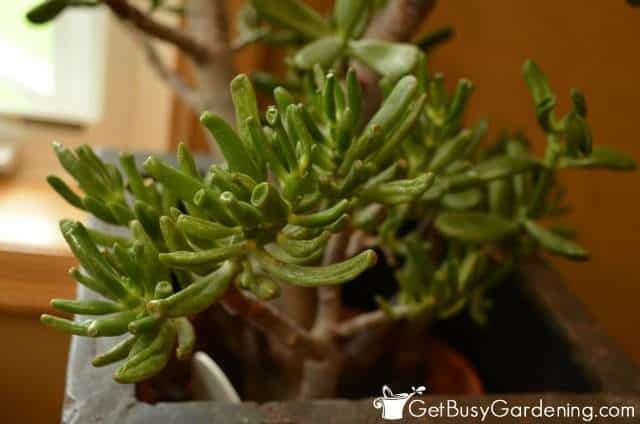
Flowers
Many people are surprised to learn that, with the proper care, jade plants can flower. In warmer climates where they grow outside year-round, they bloom during the winter. But it’s very uncommon indoors without help.
To get your jade plant to bloom, you need to give it similar conditions to what it experiences when it’s outdoors.
The trick is to give it tons of light during the summer. Then, expose it to cooler (but never freezing) temperatures in the fall, and allow the soil to dry out.
When you bring your jade back inside in the fall, put it in a sunny spot, and keep the soil dry. You should start seeing flower buds in a few weeks.
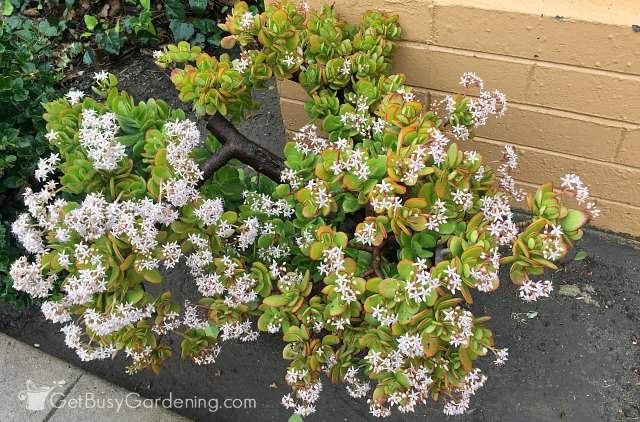
Crassula Toxicity
According to the ASPCA website, jade plants are toxic to dogs and cats if they ingest them.
My cats have never touched mine, but it’s a good idea to keep them out of reach if your pets like to snack on plants, just in case.
Where To Grow Jade Plants
If you live in a warm enough climate, you can grow your jade plant outside year-round. But they also do very well as indoor houseplants.
Hardiness
Jade plants are hardy down to zone 9. They can handle a bit of cold, and are even tolerant of light frost. But they will eventually die if it stays cold for too long.
If you live in an area with harsh winters, then you’ll either need to bring your plant indoors for the winter, or keep it as a houseplant.
Location
The best location to grow your jade plant is a sunny spot with dry soil. Outdoors, plant it in a spot where the ground is very sandy and fast-draining. Indoors grow your potted jade in a sunny, south-facing window.
You could keep it indoors year-round, or put it outside during the summer to give it a growing boost. Just make sure the pot has holes in the bottom, and bring it back inside before it drops below 60°F in the fall.
Related Post: Debugging and Cleaning Potted Plants Before Bringing Them Indoors
Jade Plant Care & Growing Instructions
For the most part, caring for jade plants is easy. But they do have some pretty specific growing requirements. So, for best success, follow my detailed instructions and tips below.
Watering
The biggest mistake that people make with jade plant care is overwatering, and this is their #1 cause of death. Too much will cause root and stem rot, quickly killing your plant.
You can learn exactly how to properly water your jade plant in this guide, but here are a few quick tips:
- Let the soil dry at least 2-3″ deep before giving your plant more.
- When it’s time, water deeply until it starts running out the bottom holes, and let it drain away completely.
- Give your plant less in the winter, and slightly more during the hot summer months.
- If you struggle with getting it right, get yourself an inexpensive soil moisture gauge to make it easy.
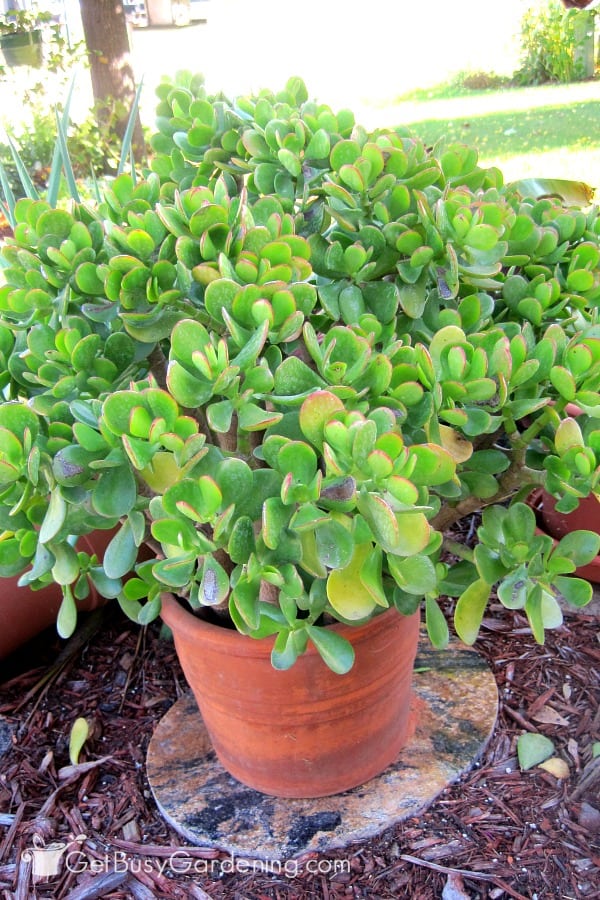
Light Requirements
Though they will tolerate partial shade, jade plants grow best in a full sun location. If it’s too dark, especially indoors, the stems and branches will become weak, thin, and leggy.
With enough sunlight, the stems and leaves will be thick and compact, and the trunk will turn brown and woody at the base. Also, the leaves or tips of your jade plant will turn red, making them even more beautiful.
Here’s are my tips to figure out the ideal amount light for your plant:
- Indoors – Place your plant in a sunny, south-facing window. If you don’t have enough natural sunlight in your house, then add a grow light to supplement.
- Outside – Grow your jade plant in a full sun to partial shade location. If it gets too much shade, then the leaves will stay green and your plant won’t flower.
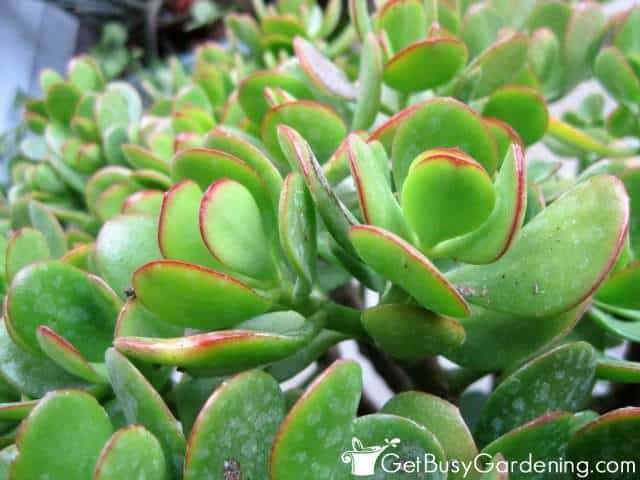
Temperature
Jade plants grow their best when the temps are between 55-85°F. They can handle occasional frost, but they’re not very cold hardy.
They’ll also survive brief periods of freezing temperatures, but will start to suffer if it’s cold for too long. So make sure to protect your plant or bring it indoors if it’s going to stay below 45°F outside.
On the flip side, they can handle the heat in the summer. But the leaves can start to shrivel in extremely hot and dry weather. So you should give your jade a little extra water during extended heatwaves.
Best Soil
Using the correct soil for your jade plant is a crucial part of their care. They need a porous and quick-draining mix. General purpose potting soils hold too much moisture, and can cause your plant to rot.
You can buy succulent soil, get a gritty commercial mix, or you can make your own by mixing coarse sand, potting soil, and perlite.
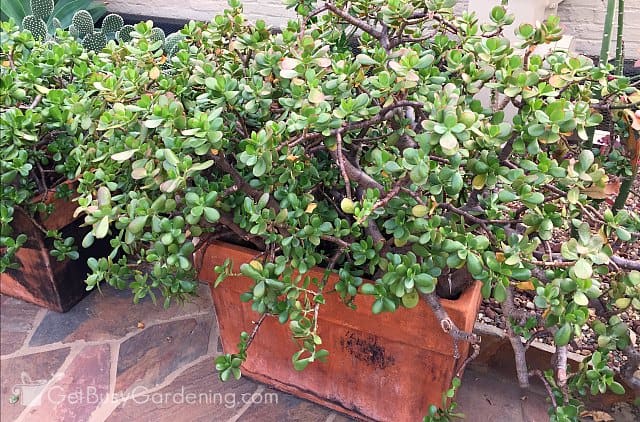
Repotting
Jade plants have very shallow roots, so they can live in the same pot for many years. In fact, it’s better to keep your plant a little root-bound, rather than repotting it too often.
When the time comes, choose a container that is 1-2 sizes larger than the current one. I recommend using an unglazed clay pot, but plastic or another type will work, as long as it has drainage holes in the bottom.
Fertilizer
You don’t need to worry too much about fertilizing as a part of your regular jade plant care routine. But it will help to encourage faster growth and flowers.
Apply a general purpose liquid monthly during spring and summer, or top-dress with slow-release granules once or twice.
Jades go into a dormant state during the colder months, and you should let them rest. So don’t fertilize during the fall and winter, or the new growth will probably be weak and leggy.

Pest Control Tips
Healthy jade plants don’t usually have problems with pests. But sometimes mealybugs, scale, or spider mites can attack them, especially indoors.
You can spot-treat small infestations by soaking a cotton swab in rubbing alcohol and using that to remove the bugs. For a larger or persistent outbreak, treat your plant with neem oil or a insecticidal soap.
Jades can be sensitive to some types of sprays though. So test any product that you want to use on a couple of leaves first to make sure there’s no damage before you treat the whole plant.
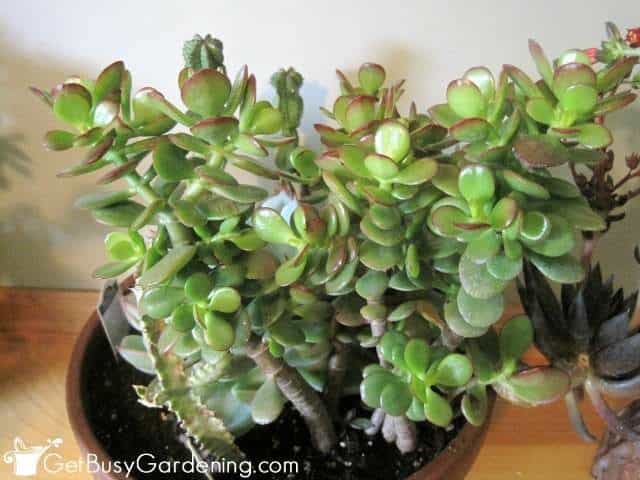
Pruning
Regular pruning is another important part of jade plant care. It will help to keep the foliage compact, and encourages the stems and the trunk to grow thicker.
Pinch off the new tips as they form in the spring or early summer, and use a sharp pair of precision pruners to trim leggy growth and encourage branching.
Get my full step by step instructions for when and how to your prune jade plant here.
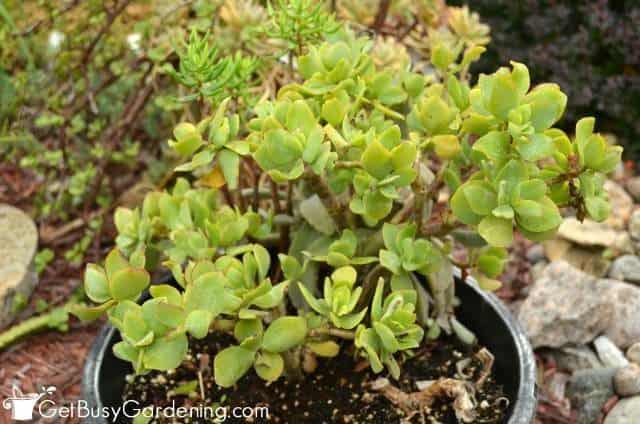
Propagation Tips
Jade plants are extremely easy to propagate, and you can grow tons of new babies by rooting either stem or leaf cuttings.
Allow the cut area to dry for a few days, then dip it in rooting hormone. Plant it in a slightly moist, well-drained soil mix, and in a few weeks it will form roots.
If you want to learn more about how to do it, then check out my detailed step-by-step jade plant propagation instructions here.
Troubleshooting Common Problems
In this section, I’ll help you troubleshoot some of the most common jade plant care problems you may have, with tips for how to fix them.
Leaves Or Branches Falling Off
When the leaves or branches start dropping off, it’s almost always caused by improper watering (usually too much), but it could be from a bug infestation.
Inspect your plant for signs of bugs, and treat any that you find. Ensure the soil dries completely before giving more, but never to the point where the leaves start shriveling or the plant droops. Use a moisture gauge to get it just right.
Mushy Or Rotting Stem Or Leaves
When the stem, branches, or leaves are brown and mushy, then it means they are rotting because of excessive moisture.
If they’re rotting on the top of your jade plant, then you can just prune off the affected parts. Otherwise, if the main stem is mushy, then you’ll have to take healthy cuttings to start new plants.
Leaves Turning Brown
This could be caused by improper watering or sunburn. If the brown leaves are soft and mushy, then they’re rotting from overwatering. Otherwise if they’re dried up and crispy, then your plant isn’t getting enough moisture
Ensure you’re giving your jade the correct amount of moisture, and harden it off before moving it into the full sun to prevent burning.
Trunk & Stems Turning Brown
It’s normal for the main trunk and branches to turn brown and become woody with age, and it means that you’re doing a great job of caring for your jade plant. However, if smaller stems suddenly turn brown after moving them into the direct sun, it is from sunburn.
In that case, move your jade back to the shade, and slowly acclimate it to the full sun over a period of a few weeks.
Shriveling Or Drooping Branches Or Leaves
When the leaves or branches shrivel, that usually means your jade plant isn’t getting enough moisture.
However, it can also be a sign that the stem has rotted. If the base is not mushy, then water your plant more often. Otherwise, treat it for rot.
Roots Growing On The Stem Or Branches
When roots grow on the stem or branches, they are called “aerial roots”. Though it’s not always a problem, this can be triggered by under watering, and also happens when the main stem is rotting.
Ensure your jade is getting enough moisture, and check the entire stem for signs of rot. If all is good, then you can just prune off the stems with aerial roots if they bother you, or leave them be.
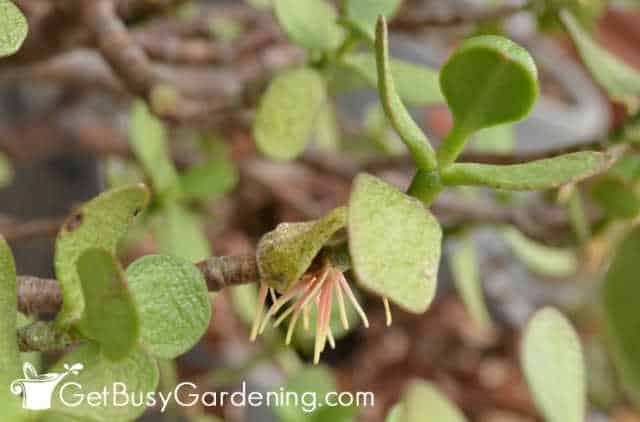
FAQs
Below I will answer some of the most frequently asked questions about growing jades. If you can’t find the answer to your question here, ask it in the comments below.
Is a jade plant indoor or outdoor?
You can grow jade plants either indoors or outdoors, depending on where you live. They aren’t cold hardy though, so you must move them indoors in freezing weather (anywhere less than zone 9).
Do jade plants go dormant?
Though jade plants don’t go fully dormant, they do go into a resting state in the cooler winter months. During this time, growth will slow, and they don’t require as much water.
Does a jade plant like to be root-bound?
Yes, jades like to be root-bound, and can live in the same pot for many years. Their root system isn’t very large, so keeping them in a smaller pot will help prevent overwatering.
Jade plants are easy to care for, and beautiful too. If you follow my detailed tips in this guide, you’ll have no problem keeping yours growing and thriving for decades to come.
If you want to learn all there is to know about maintaining healthy indoor plants, then you need my Houseplant Care eBook. It will show you everything you need to know about how to keep every plant in your home thriving. Download your copy now!
Share your jade plant care tips in the comments section below.


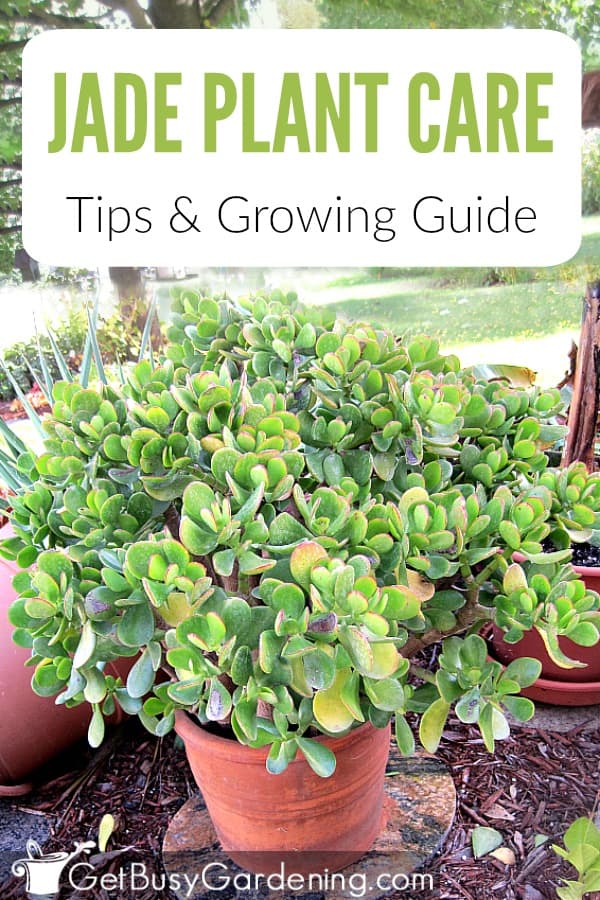
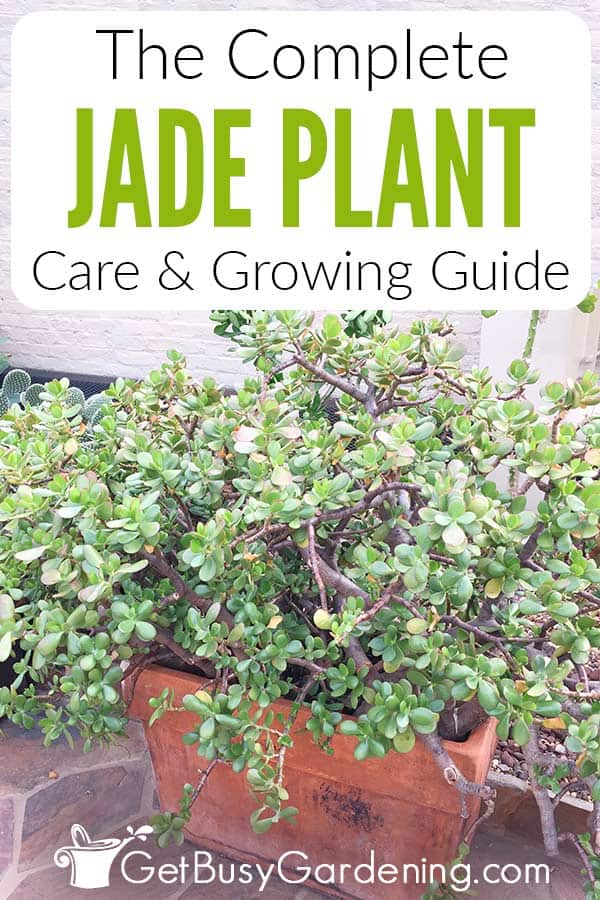
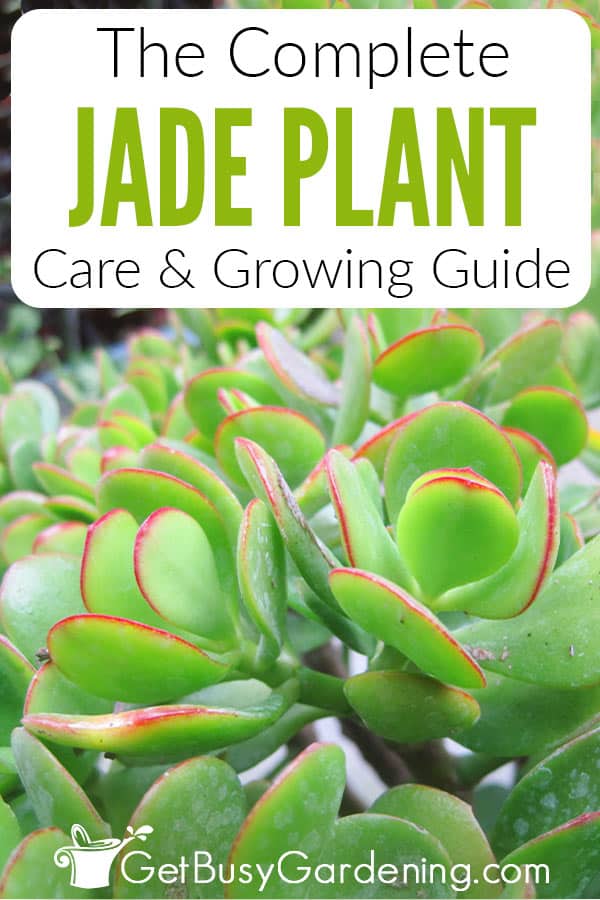
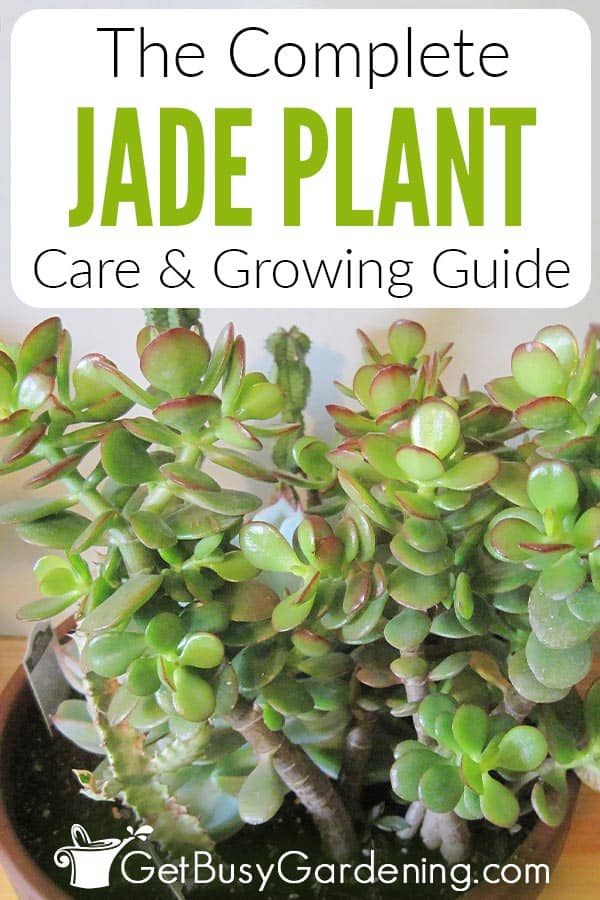
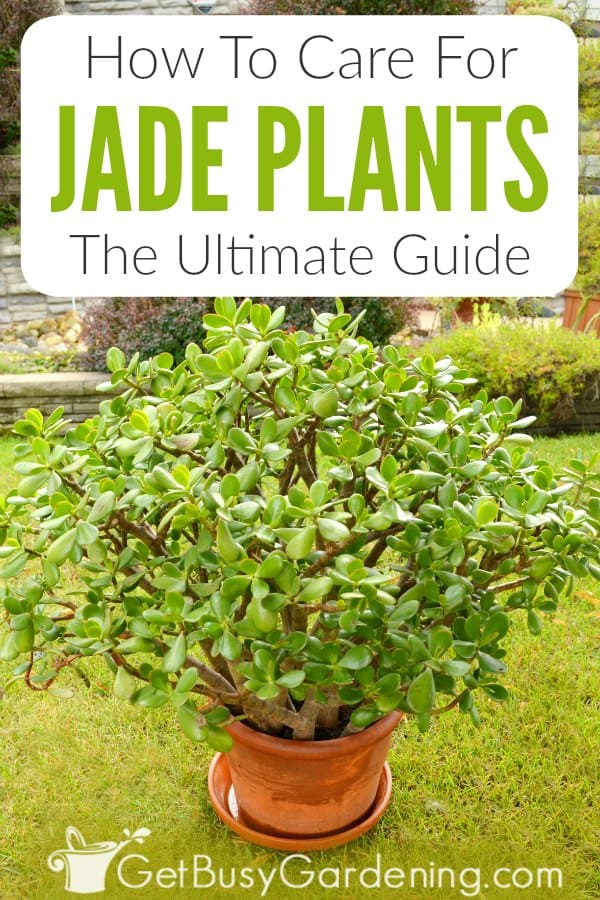
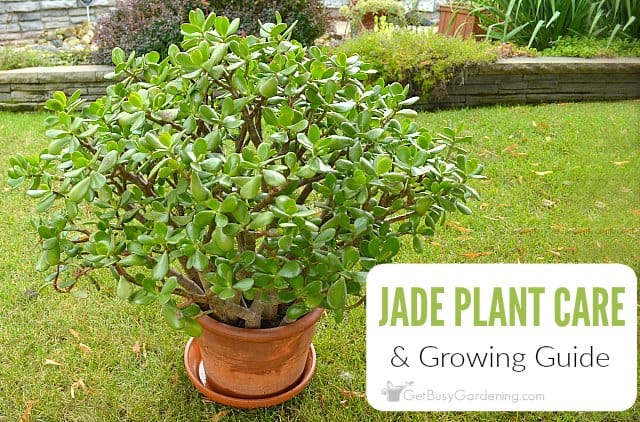




Katie says
Hello, thank you for this incredible post. I found the link as I was googling how to clean my little jade. She has gotten quite dusty, and although I use Safer brand cleaning spray on some of my succulents with great results, I did read that I should never spray jade. Well, it doesn’t really need any Safer soap — it’s just dusty, and as summer is coming I’m hoping it will come out of dormancy and get some new growth. Your post didn’t give me an answer to the question of dust, but it did give me lots of other great info and I’ve ordered items that you recommended for succlent care — I got the moisture sensor, some succulent food, and some turface. I have been struggling with getting the soil just right for my succulents, and some have died as a result. It’s very daunting. But when the turface arrives I’m going to try your DIY soil recipe. If you are stil catching comments for this post and are reading this could you let me know how I might go about dusting off my plant without having to use too much water? Thanks!
Amy Andrychowicz says
Yes, keeping the leaves free of dust is a good idea and will help your jade plant grow and look it’s best. You could use a damp cloth to hand wipe your jade plant leaves if you’re worried about accidentally overwatering it by spraying it with water. Good luck with the DIY soil, it should work great. You could also try potting your jades in terracotta pots to help the soil dry out faster. That’s what I do. 🙂
Cortney Hester says
Advice.I have a gollum jade plant that I’ve had for approx 5 years. I have kept it in the house until recently when it had out grown the pot it was in and was dropping to the side. I’ve never overwatered it. This is the third repotting since I bought it. This time I left it outside to get more sun due to the drooping. Not mushy, not overwatered, not underwatered, the tubal leaves are plump. But it is still drooping. Is there something I am missing?
Amy Andrychowicz says
I may just be that your jade plant is so large and top heavy, it’s drooping under it’s own weight. Have you ever pruned it? That might be something you want to try this spring.
Tracy Messer says
I have a jade tree an it eas doing good till I set it outside an it got colder that night than I thought. Then 2 days later almost all the leaves feel off. There is still sine small ones an the trunk is still solid. What would cause that an week it grow the leaves back?
Amy Andrychowicz says
It sounds like the cold is what caused your jade plant to drop most of it’s leaves. Check the tips of the stems to make sure they are still firm and healthy, and prune off any mushy tips or branches (that means they were probably frozen, and will only die). As long as the stems and the trunk are still firm, then your jade plant will grow back.
Stephanie says
Hi! I just bought a mini indoor jade plant and the seller told me to put it outside for sunlight once a week. But you said that it needs a lot of sunlight.
How many hours should I let it be under the sun? And how many times per week? Thank hank you!
Amy Andrychowicz says
I do not recommend moving your jade plant outdoors once a week. If you take a jade plant that’s used to growing indoors and put it outside into the direct sun, it will burn the leaves and can cause major damage to your plant. I would either grow it indoors year round, or put it outside during the entire summer (slowly moving it into the sun) then bring it indoors during the winter. Once they are used to being outside in full sun, they can stay in the full sun all day long. If you’re growing it indoors, then you can either put it in a sunny window, or add a grow light and keep that on for 8-12 hours a day.
Aswathy Kallazhi says
Hello, I have two baby crassula ovata plants in a 3.5 inches deep pot. I adopted it recently (no previous gardening experience but found it left behind) and followed instructions from your post on watering and light. It has now started looking healthy, sprouting new leaves with red rim and its happy and beautiful! Thank you! Now it has 6-8 leaves, the stem is green but healthy. At what point should I re-pot it into a bigger pot?
P.S: I live n Sweden and it is still winter.
Amy Andrychowicz says
Wonderful, I’m so glad that you were able to revive your jade plants using my tips! That’s so great to hear! The best time to repot jade plants is in the spring, so I would recommend waiting until early spring.
Aswathy Kallazhi says
Great! I will do that. Thank you very much! Your website is wonderful!
Amy Andrychowicz says
You’re welcome! And I’m glad you love my website too, so nice to hear that! 🙂
Jo says
Wow! Amy, your site is absolutely fascinating! I couldn’t stop reading all the questions and your very informative replies! I was given a Jade plant recently which I’m told was originally in the soil and was pulled out and neglected. A very kind neighbour nurtured it back to health and potted it for me. He DID tell me to water it twice a week and also he gave me home-made fertiliser which he said to use once a week!! The stem is very thick so I’m assuming it’s pretty old and it seems to now be flourishing on my balcony in Sydney. I’m so glad I found your site to show me how to look after it properly. Thanks again!
Amy Andrychowicz says
Awe, thanks! I’m so glad you’re enjoying my website. 🙂 You’re welcome for the tips, I’m so glad that I could help you care for your jade plant.
Pat McCabe says
I have a 25+ year old jade plant that’s huge. A couple years ago, it developed some reddish brown spots and stickiness/sap that actually drops on the floor around it. There doesn’t appear to be any bugs. I’ve tried completely pruning it back to the main stems, and it grows out but again develops this condition. Any suggestions?
Amy Andrychowicz says
I would definitely keep an eye out for bugs, that is usually the only reason jade plant leaves are sticky like you describe. The reddish brown spots you describe sounds like houseplant scale to me. They don’t look like bugs at all, they just look like weird spots or bumps on the plant. Keep in mind that these houseplant pests start out very tiny, and you usually won’t even notice them until the population grows very large. Here’s info about scale insects, along with detailed information about how to get rid of them.
Hosein says
Thank you for all the information
My jade plant is dying it has lost all its leaves and I hope I can save it taking your advice.
Thank you very much.
Amy Andrychowicz says
Definitely check the stem of the plant, all the way down to the soil. If it’s mushy or hollow, then you’ll need to take healthy cuttings to propagate because the rot will only spread and end up killing the entire plant. Overwatering is the number one killer of jade plants. But if the entire stem feels firm and healthy, then you may need to give it more water through the winter months. I hope you’ll be able to save your jade plant!
Alex Saldivar says
Hi Amy, thank you for all the great info. I have a mini jade plant that I keep indoors in my apartment. It did not get enough sunlight in the beginning and a bunch of leaves started coming off. I bought a grow light and it got a little better but now the tree and branches are wrinkly and pruning. There are practically no leaves and branches are still slowly falling. I only water it like once a week (soil is dry). The grow light is anywhere from 2-6 inches away from the plant. I’m not sure what else I can do. I just want it to be healthy again. I have some pictures but I’m not sure how to send them. Any help would be great. THANKS!
Amy Andrychowicz says
Lack of light won’t cause the leaves to shrivel and drop. The way you’re describing the stems and leaves, it sounds like the plant is either not getting enough water, or it is dying because the base is rotten and your jade plant can’t get any nutrients. Watering a jade plant once a week sounds like a lot. I don’t even water my small plants in 4″ pots that often during the winter. I’m worried that your jade plant may have been overwatered, and the base is rotting. Check all along the main stem of the plant to see if any of it is mushy. If so, then you’ll have to take healthy cuttings and propagate them to save your plant (here’s how to propagate jade plant cuttings). When you check the soil, be sure to stick your finger an inch into the soil. Sometimes the top layer can be completely dry, but the soil underneath is still wet. Otherwise, if the stem is pretty firm and seems healthy, then maybe it’s not getting enough water after all. If that’s the case, then I would look at potting it up into a larger container so that the soil won’t dry out so quickly. I water my large jade plant a couple of times all winter long, and my 4″ jades about once a month (if that) to give you an idea.
Andrew Freezer says
I had a huge jade plant for about 40 years I planted it higher in the pot to expose the roots and trimmed it back as a bonsai. when we moved house it got put away in the back of a cupboard I assumed it had been lost or stolen. when I eventually found it ,it had been in the dark without water for 18 months. The soil in the pot had shrunk to nothing and the plant had dropped all its leaves. It looked like a piece of drift wood. I presumed it was dead but had become quite attached to it so I put it in a bucket of water with a brick on it to hold it down for a day then repotted it. in less than a week it was covered in buds and it recovered in just a short while. That year it flowered the only time I have ever seen it flower hundreds of tiny white five pointed flowers. Crassulas are desert plants and sometimes get no rain or water for very long periods but a year and a half!!
Amy Andrychowicz says
WOW! That is an amazing story! I’m so glad to hear your jade plant recovered, I was so sad when you said you presumed it was dead. Amazing!
Andrew Freezer says
Crassulas are from the desert in south Africa, sometimes they don’t get rain for a year, but when they do they rush to make seeds hence lots of flowers quickly, may be the way to make them flower.!! treat them rough they seem to love it
Amy Andrychowicz says
Yes, for sure! They thrive on neglect. 🙂
Bridget says
Any tips on keeping your cat out of the Jade plant? My cat loves to chew on plants so I have to be careful about what I bring in the house.
Amy Andrychowicz says
Yes, I have a cat that likes to chew on plants too (especially when I tell her NO! LOL!). I use bitter apple spray, and cats hate it. It’s cured her of chewing on cords, shoes and other stuff around the house. Disclaimer though… I’ve never tried it on my jade plant before, so I would recommend that you spray a few leaves to test and make sure it doesn’t damage the plant before spraying the whole thing. I’ve used it on a few of my other plants without any problems. Here are more tips for keeping cats out of houseplants. Good luck!
Kris says
I have a large jade plant that I moved outside for the summer. We have had a very wet summer her in upstate NY and it keeps getting rained on. It’s planted in succulent soil in a plastic pot with several drainage holes. Is it bad to put a plastic leaf bag over it when it’s pouring? It’s too heavy to move in and out of the house but it keeps raining and I’m worried about it. I keep draping this bag over it but when I take the bag off, the bag has an odor that is quite strong. I’m not sure if it’s bad for the plant to do this.
Amy Andrychowicz says
If it’s raining more than usual this summer, I would move the jade plant inside early for the winter, and let it dry out completely before giving it any more water. But, if your plant is in a full sun location, and gets a few days to dry out between rain storms, then it will probably be fine (as long as the pot has plenty of drainage). As for your plastic bag trick… I would be careful with that. You might end up holding in too much moisture, which can cause fungal issues on the leaves. If you can, I recommend putting your jade plant into a clay pot rather than a plastic pot. That will help the soil dry out faster, and lower the risk of overwatering.
Kris says
Thanks very much for the advice!
Sarah says
Hi. I’ve no idea how old this post is, but maybe you can help? My jade plants are fine at the top but the lower leaves have gone a funny colour then they rot and drop off. They aren’t over-watered, although I didn’t know to water from the top as most plants get watered from the bottom. Should I start again? And if so, should it be with new plants rather than cuttings from these?
Amy Andrychowicz says
The first thing to do is check the stem to see if it’s rotting. If the stem is mushy, that’s why the leaves are rotting and falling off. It sounds like you’re talking about cuttings that you’re trying to propagate? If that’s the case and the stem is mushy, then you’ll have to start over with new cuttings. Here’s a post I wrote with detailed steps for propagating jade plants from cuttings.
And, you don’t *need* to water jade plants from the top, but it makes it easier to ensure you’re not overwatering them. When you water plants from the bottom, the top layer of soil tends to stay dryer so it’s harder to tell when the soil is actually dried out, or if the rootball is still wet.
Paulla says
Do jade plants like to be crowded in a pot or have lots of room in a larger pot? Thanks!
Amy Andrychowicz says
They aren’t picky about space. I’ve had my large jade plant growing in the same pot for probably 10 years or so, and I also have a few jades that have lots of room in their pots.
Pinaki Mondal says
Hello ,
I bought both CRASSULA OVATA, AND GOLLUM but unfortunately both trees are dying i dont know why both jade are suffering ..
both trees are on my roof (east side) where they received only 4-5 hours morning lights directly, (as my roof covered.)
I never over watered but still i dont know why they are dying ..
Problems: Ovata’s leaves become dry and black and also its branches .
same happens with gollum leafs are look like dry, then black ..
what is the peoblem ?
Please help
Amy Andrychowicz says
It sounds to me like your jade plants are getting too much water. When you say your jade leaves are turning black and falling off, that sounds like rot to me. I would check the soil to make sure it’s not wet. Stick your finger down into the soil as far as you can to see if you feel any moisture. You can also slide the plants out of their pots and check the soil that way too (which is sometimes the best way to make sure the soil isn’t too wet). If you find the soil is wet, then you can leave them out of their pots to help it dry out faster.
Ajit says
Hi
I really some help with my jade plants.
Bascially they are growing very large and heavy.
They are hitting around 1.5m in height.
The pots are becoming to small.
The plants keep breakong because they becoming heavy.
We have 4 large plants.
Would you recommend any types of spray to keep the plants healthy.
What so we do if we cannot find larger pots to replant?
Thank you
Ajit
Amy Andrychowicz says
It sounds to me like your plants are already extremely healthy, so you don’t need to spray them with anything. Do you live in a climate where it’s warm enough to plant them outside in the ground? If not, then I would recommend pruning your jade plant to keep it at your ideal size. You can prune it down to the size you want it, and then pinch out the new growth regularly to keep it compact. After you prune it, you can propagate the cuttings and give them away to friends. Here’s how to propagate jade plant cuttings.